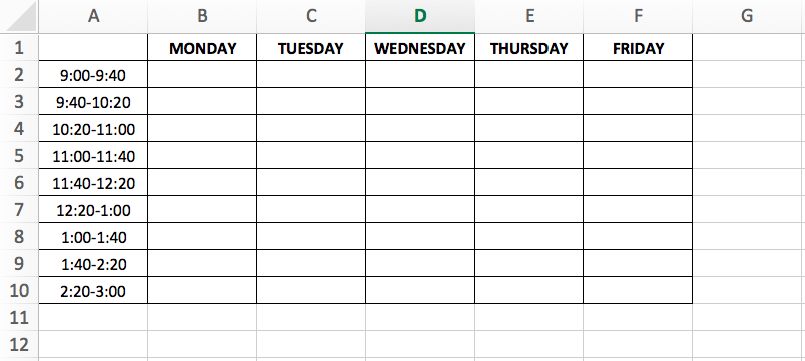3:1 Model & Me: Part 1

We’ve now made it through almost 5 weeks of this school year! This year, I am fully implementing the 3:1 model with my scheduling. My district has had in place last year, but I was only able to make it half work. We call it flexible scheduling in my district, rather than the 3:1 model. Click here if you’d like to read more about this.
If you’re unfamiliar with it, the premise is three weeks of direct service and one week of indirect service. Sounds simple, right? Sort of. I write my speech therapy minutes in IEPs monthly (i.e. 3 hours/month, 4 hours/month) so this might not work for you if you are required to write yours weekly.
The title of my blog post says “Part 1” because right now, I’m going to chat about some of the pros/cons that I’ve experienced so far. I plan to write “Part 2” at the end of this school year with a more in depth review of my experience.
Let’s get started. First of all, I make my schedule in Excel. So it looks like the screenshot below:

I chose to do 40 minute sessions. I’ll see my 2 hour/month kids for 3 sessions, my 3 hour/month kids for 4 sessions of 40 minutes and 1 session of 20 minutes, and my 4 hour/month kids for 6 sessions.
Pros:
-Thus far, I’m liking the slightly longer sessions. I feel like I can get more trials and more real work done this way. As we school SLPs know, there can be some wasted time going to get kids and take them back to class.
-I’ve explained the model to teachers and parents (I use the term “flexible scheduling”) and haven’t received any questions or negative feedback. Though I will say, I am very lucky and the majority of my teachers are very good about letting me schedule as I see fit.
-I like knowing that I’ll have the one week to do makeups if I need to. As you know, in schools tons of events or things happen that I have no control over, which results in missed sessions.
-This week has been my first indirect week. By tomorrow, I will have tested 5 students (all with interpreters) and I’ve had time to write all the reports at work (which is huge). If I can keep scheduling the bulk of my testing during the indirect week, it will significantly cut down on the amount of therapy sessions I have to cancel.
Cons:
-One major con is the loss in number of sessions I have available daily. When I used to see kids on the half hour/hour, I had 10 sessions a day. Now I only have 8 (since I need a lunch). This has resulted in me having to make groups bigger and I know once I start adding more kids, that the groups may grow even more.
-It is nearly impossible to ONLY have meetings during the indirect week. When I’ve had to attend meetings, they are on the hour/half hour – so I have to miss two groups most of the time. That hasn’t been too big of an issue yet, but it might become one later on as I have more and more meetings to attend.
-For some of my kids, particularly the ones with autism, the longer session can be more challenging. So far, I have been offering 2 breaks, whereas before I offered maybe 1, depending on the child.
Overall, I’m liking it so far. I will be sure to add Part 2 towards the end of the year. If you’ve implemented the 3:1 model, what do you like? Dislike? Tell me in the comments!!
